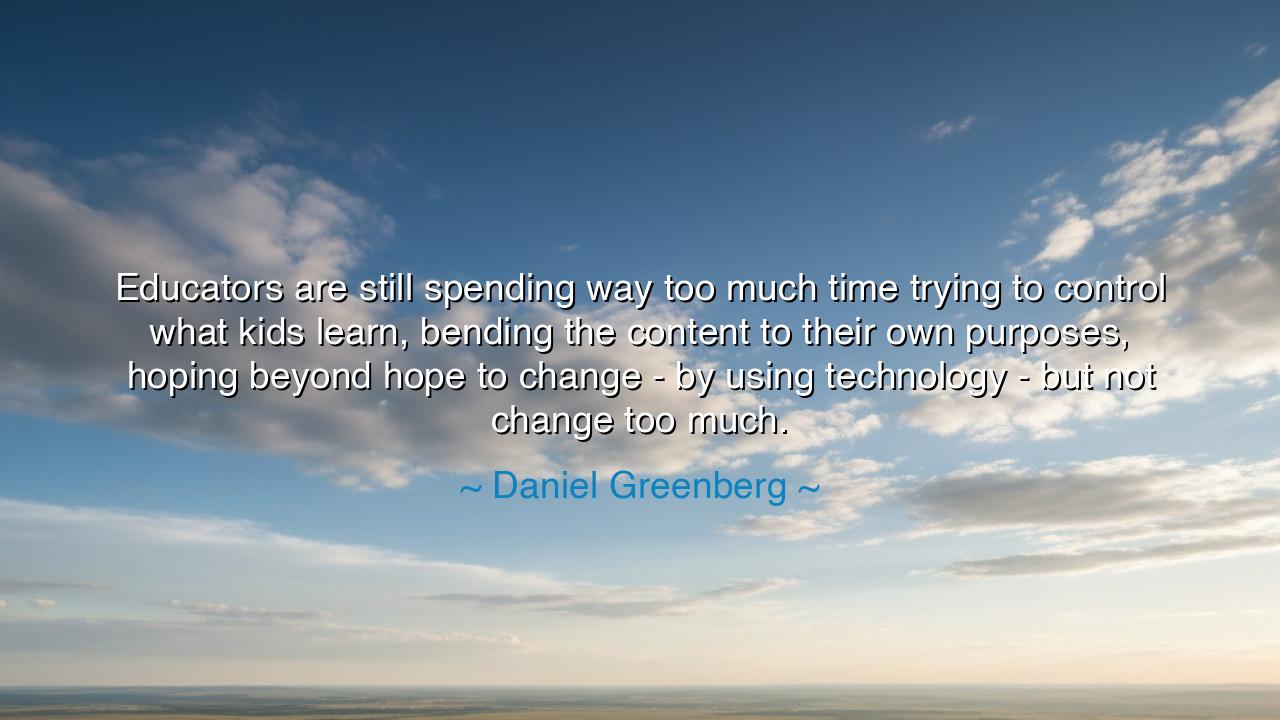
Educators are still spending way too much time trying to control
Educators are still spending way too much time trying to control what kids learn, bending the content to their own purposes, hoping beyond hope to change - by using technology - but not change too much.






The words of Daniel Greenberg—“Educators are still spending way too much time trying to control what kids learn, bending the content to their own purposes, hoping beyond hope to change – by using technology – but not change too much”—resound like the cry of a reformer, weary of old patterns repeating themselves under new names. At their core, these words warn us that the chains of control still bind the spirit of education, even when adorned with the glitter of technology. Teachers and institutions, instead of liberating the mind, too often seek to bend it toward their own purposes, shaping the young not into seekers of truth but into obedient vessels of tradition.
The origin of this wisdom lies in Greenberg’s founding of the Sudbury Valley School, a place where children were not forced into rigid curricula but given the freedom to direct their own learning. He had seen the futility of systems that preached innovation but clung to the same old control. In his eyes, even when computers, tablets, and digital platforms entered the classroom, they were too often harnessed not to liberate, but to reinforce the authority of the teacher. What was promised as transformation became merely a shinier version of the same cage.
Consider the story of Socrates, who long before technology stood before the youth of Athens, refusing to dictate doctrines, but instead asking questions. His method was not to control what his students thought, but to awaken in them the power to think for themselves. For this he was condemned, accused of corrupting the youth. Yet his way lives on as proof of Greenberg’s truth: real education is not control, but liberation. When teachers impose too much, they suffocate the spark; when they trust the learner’s own curiosity, wisdom flourishes.
The danger Greenberg names is subtle but deadly. Schools adopt technology—smartboards, learning platforms, data systems—and declare themselves modern. But if the heart of the system remains unchanged, if the teacher still bends knowledge toward their own agenda, then nothing has truly shifted. The chains are polished, but they remain chains. True change is frightening to the old guard, for it demands surrendering control, trusting children to explore, to fail, to rise, to learn not because they are commanded but because they are alive.
And yet, there is hope in his words. For though educators may cling to control, the nature of the human spirit is restless. Children are born curious. They hunger to know, to explore, to master. Even under control, their questions burst through, and with the vast horizon of technology now available, their capacity to seek truth is greater than ever before. The task of the teacher, then, is not to bend the content but to guard the flame, to give space for exploration, to let learning breathe.
The lesson is clear: education must move from control to freedom. To prepare children for the future, we must cease clinging to the illusion that we can determine precisely what they learn, or when, or how. Instead, we must trust the power of curiosity, the resilience of self-directed discovery, the immense potential of combining youthful wonder with the tools of technology. It is not the role of the teacher to mold minds into uniformity, but to cultivate the garden where diverse minds may bloom.
In practice, this means rethinking education itself. Teachers should guide, not dictate. Curricula should be flexible, not rigid. Technology should not be used as a leash, but as a key—unlocking doors, expanding horizons, connecting learners with worlds beyond their classroom. Parents and societies alike must learn to prize not the obedience of the child, but the independence of thought, the courage to question, the joy of discovery.
So let Greenberg’s words echo like a bell across generations: education must change, and it must change deeply. To control the learner is to impoverish them; to free the learner is to ennoble them. If we dare to release our grip, to let children learn with patience, with courage, with the aid of tools that open rather than confine, then the future will be filled not with obedient servants of tradition, but with wise creators of new worlds. And that, truly, is the purpose of education.






AAdministratorAdministrator
Welcome, honored guests. Please leave a comment, we will respond soon